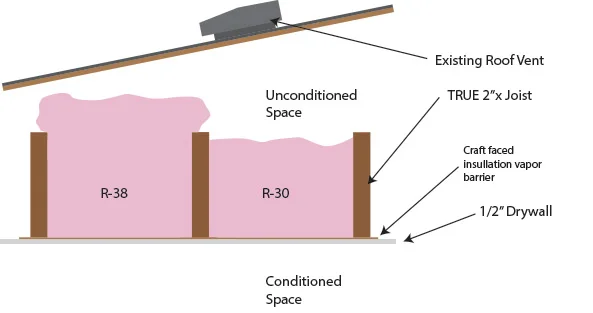R30 vs R38 Insulation:

Introduction
When it comes to optimizing home insulation for energy efficiency, the choice between R30 and R38 insulation plays a pivotal role. R30 and R38 insulation refer to the thermal resistance, or R-value, of the insulation material. Understanding the difference between these two options is crucial for making an informed decision that can lead to significant energy savings and enhanced comfort within your home. R30 insulation offers a specific level of insulating effectiveness, while R38 insulation provides even higher thermal resistance. By comprehending the distinctions between R30 and R38 insulation, homeowners can make informed choices that align with their specific energy efficiency goals and requirements. Let’s delve into the nuances of R30 versus R38 insulation to gain insight into their impact on efficient home insulation.
R30 Insulation
When it comes to optimizing home insulation for energy efficiency, the choice between R30 and R38 insulation plays a pivotal role. R30 insulation, with its high thermal resistance indicated by an R-value of 30, provides excellent insulation performance. This means it offers improved energy efficiency and reduced heat transfer, contributing to a more comfortable and cost-effective living environment. The use of R30 insulation in home insulation brings numerous benefits, including enhanced temperature regulation, lower energy bills, and a reduced environmental impact. Understanding the features and advantages of R30 insulation is crucial for homeowners aiming to make informed decisions about their insulation needs, ensuring a more energy-efficient and sustainable living space.
R38 Insulation
R38 insulation, with its superior thermal resistance denoted by an R-value of 38, stands out as a high-performance solution for enhancing home energy efficiency. This type of insulation offers advanced thermal protection, effectively minimizing heat transfer and bolstering the overall energy performance of residential spaces. Choosing R38 insulation presents homeowners with significant advantages, including unparalleled insulation effectiveness, reduced energy consumption, and a notable impact on creating a more sustainable living environment. By comprehending the distinctive features and benefits of R38 insulation, individuals can make well-informed decisions that align with their energy-saving goals, contributing to a more comfortable and eco-conscious home.
Comparison of R30 and R38 Insulation
When deliberating between R30 and R38 insulation, understanding the differences in their R-values is crucial for making an informed decision about home insulation impacting insulation effectiveness. The choice between these insulation types hinges on various considerations, such as the climate, building design, and energy-saving goals. By contrasting the R-values and considering the specific requirements of the property, homeowners can navigate the decision-making process effectively. This comparison provides valuable insights for selecting the most suitable insulation solution, ensuring optimized energy efficiency and enhanced comfort within the home.
The price difference between R30 and R38 insulation
Determining the price difference between R30 and R38 insulation involves considering various factors such as the area requiring insulation, the quality of the materials, and potential installation expenses. Market fluctuations and regional variations can also influence pricing. By conducting a comprehensive cost analysis that encompasses these variables, homeowners can gain clarity on the financial disparity between R30 and R38 insulation. This understanding is pivotal in making an informed decision that aligns with both budgetary constraints and the goal of optimizing energy efficiency and thermal resistance within the home. Selecting the most suitable insulation, taking into account both initial investment and long-term benefits, ensures a well-informed and cost-effective approach to enhancing the property’s insulation effectiveness.
Is R38 insulation enough
When considering the adequacy of R38 insulation, it’s essential to evaluate various factors such as climate, building design, and energy efficiency goals. R38 insulation, with its higher R-value, offers enhanced thermal resistance compared to lower R-value options. By conducting a comprehensive assessment of the property’s insulation needs, homeowners can make an informed decision regarding the sufficiency of R38 insulation. This evaluation involves considering the specific requirements of the home, and ensuring that the chosen insulation solution aligns to create an energy-efficient and comfortable living environment. By weighing these crucial factors, individuals can confidently determine if R38 insulation provides the optimal level of thermal resistance for their property, contributing to long-term energy savings and improved comfort
Is R30 enough insulation for the attic
When deliberating on the sufficiency of R30 insulation for the attic, it’s vital to consider several key factors such as climate, energy efficiency objectives, and building design. R30 insulation offers a certain level of thermal resistance, but its adequacy hinges on the specific requirements of the property. By conducting a thorough assessment that encompasses these variables, homeowners can confidently determine if R30 insulation provides the necessary level of thermal performance for their attic space. This evaluation is crucial in ensuring that the chosen insulation solution aligns to create an energy-efficient and comfortable living environment. By weighing these essential considerations, individuals can make informed decisions regarding the optimal level of insulation needed for their attic, contributing to long-term energy savings and improved comfort.
Conclusion
When comparing R30 and R38 insulation, it’s important to understand the key differences that can impact a home’s energy performance. R-value, which measures a material’s resistance to heat flow, plays a crucial role in determining insulation effectiveness. R38 insulation offers a higher R-value compared to R30, providing greater thermal resistance and potentially leading to improved energy efficiency. While upgrading from R30 to R38 may involve an additional cost of around $500, it’s essential to consider the potential return on investment, especially considering suggestions that there may be up to a 25% savings associated with the higher R38 value.
Selecting the right insulation for optimal home energy performance is vital. Factors such as climate, building age, and air infiltration should be taken into account when making this decision. For instance, it’s noted that in some cases, the added cost of thicker insulation may be negated by significant air infiltration elsewhere in the home. Additionally, variations in insulation types, such as cellulose and fiberglass, can impact the required thickness to achieve a specific R-value rating. Considering these factors, homeowners can make well-informed decisions about their insulation needs, balancing cost considerations to enhance energy efficiency and comfort.
In conclusion, understanding the differences between R30 and R38 insulation is pivotal in choosing the right option to optimize home energy performance. By weighing the potential cost implications, energy savings, and the specific requirements of their property, homeowners can make informed decisions that lead to long-term benefits in energy efficiency and comfort.penguintalks.com




